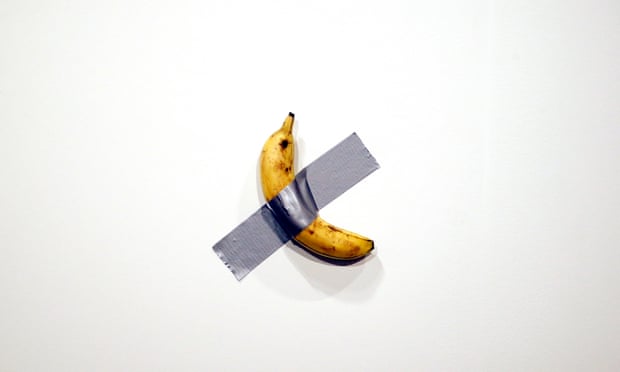Miriam El Abbassi | Arts Editor
Featured image courtesy of Rhona Wise/EPA
What is art? What does it mean for something to be deemed as art? What differentiates art from everything else? There are questions that may never be answered due to the arts being so incredibly subjective.
Let’s pretend that for argument’s sake, art wasn’t subjective, and that it exists within clearly defined boundaries. This may begin to help us explain why a banana duct taped to a wall garners the attention of contemporary art critics around the world, and why canvases painted white can sell for millions of dollars.
Today’s society tends to look at modern art with a negative connotation, with some even labeling it as pretentious nonsense. This can be due to certain viral sensations (like the duct-taped banana, which sold for $120,000) that often allude to the assumption that if something so simplistic and so easily replicable can become famous, then what’s to stop the everyday person from creating the next Jackson Pollock? And why does that “thing” gain notoriety, while the average Joe’s doodles might not?
The very simple answer to that is — nothing. Nothing is stopping anyone from duct-taping a piece of fruit to a wall or painting a large canvas with one solid colour, but it seems as though modern and contemporary art is less about skill and more about the unique idea behind it. Yes, you could do all of those things, but you didn’t (or you didn’t do it first).
If art were to exist within rigid boundaries, then there would be no space for modern art as we see it today. Visual artist, Barnett Newman, created Onement VI in the mid-1950s, a large oil painting which was merely just a solid royal blue canvas with a light blue stripe running down the centre. In 2013, this painting sold for over $40 million at Christie’s Post-War and Contemporary Art auction. Paintings done in this minimalist style became popular as they left room for open interpretation by presenting an ambiguous platform for viewers to project their thoughts onto.
The banana and duct tape piece, aptly titled Comedian, was created by Italian artist, Mauritzio Cattelan. It was shown at the Art Basel in Miami Beach where three versions of it were sold for $120,000. It soon gained viral acclaim, but mostly resulted in outrage from the public who questioned its artistic validity — how could this be considered art?
If the basis of art lies in the idea, then maybe knowing the meaning of the piece will help to justify the giant price tag. But Cattelan has never revealed what he envisioned as the actual meaning behind this piece, rather other critics and gallery owners close to him have offered their two cents.
Gallery owner, Emmanuel Perrotin, gave a statement to CNN, saying that the $0.30 banana Cattelan had purchased in the local market to use in the exhibit represents global trade, as well as the go-to comedic device in classic humour.
“Maurizio forces us to question how value is placed on material goods. The spectacle, which has been orchestrated so beautifully, is as much a part of the work as the banana,” Perrotin adds.
Could this be Cattelan making fun of modern art as an industry? One of his earlier works include a toilet, which he painted gold, and titled America. This subtle humour adds to the overall meaning of the work, strengthening its validity within the art world.
However, it’s easy to look at a toilet in a gallery and question why that is considered art, without knowing the background.
But again, who decides what is valid or invalid as art? Do these mythical gatekeepers exist in reality, or purely in the minds of individuals who pass judgment without knowing the context or history?
Or maybe it all comes down to money. A painting is only worth as much as someone’s willing to pay for it. Sure, you can say your doodles are the next Picasso, but no one is going to pay millions of dollars for your doodles. That is until someone prominent within the art world proclaims a piece to be important, therefore somehow justifying an astronomical price tag.
Even in that aforementioned scenario, there is still someone conferring value onto the piece of art. What makes that person able to so? Who determines what art is and what it isn’t?
What is considered art by a gallery curator will undoubtedly be different than what is considered to be art by the everyday person. Just like how beauty is subjective (or rather, in the eye of the beholder), that same notion can be applied to art. This is why a three-foot tall canvas with a giant orange circle can be sold for thousands of dollars, but it doesn’t make it inherently more valuable.
Someone would have had to have seen value in that piece in order to justify that price tag, but that doesn’t mean something without a price tag is without value. As long as someone out there is willing to confer value onto a piece of art, I would say that is what makes that “thing” art.



You could have saved a lot of waffle.
“Is modern art purely pretentious nonsense?”
YES !